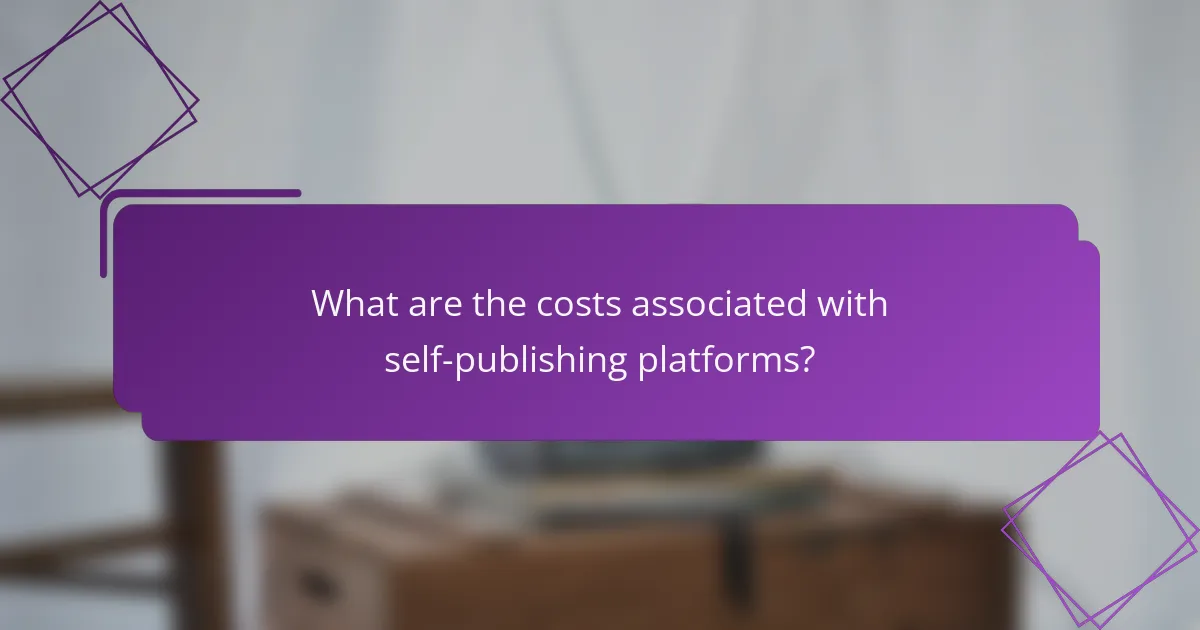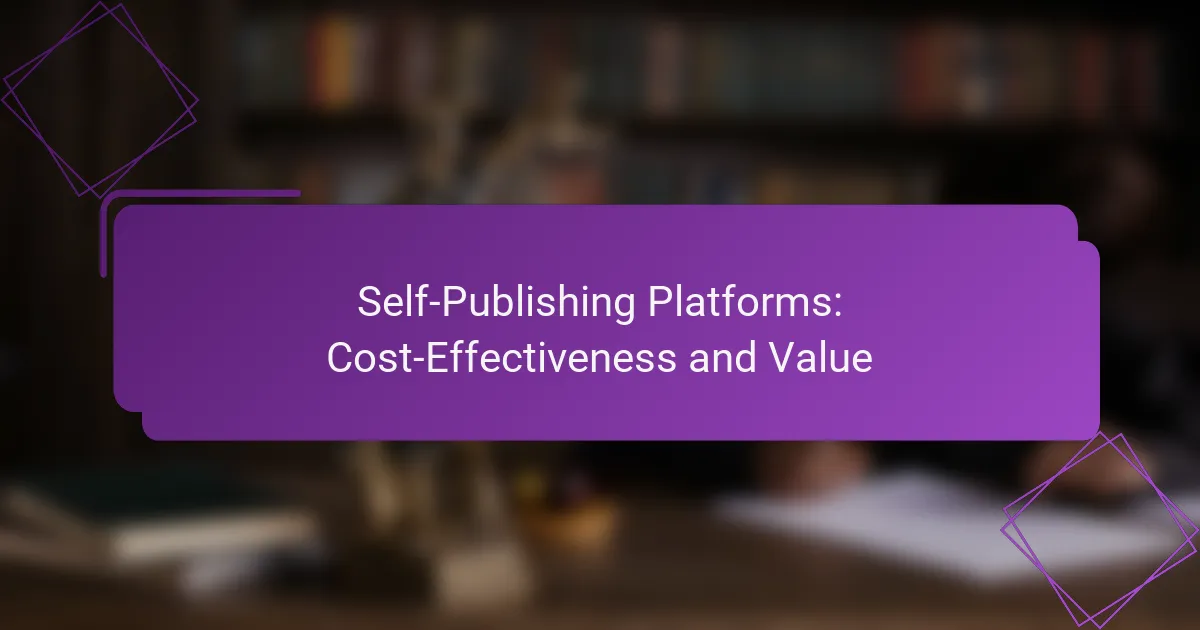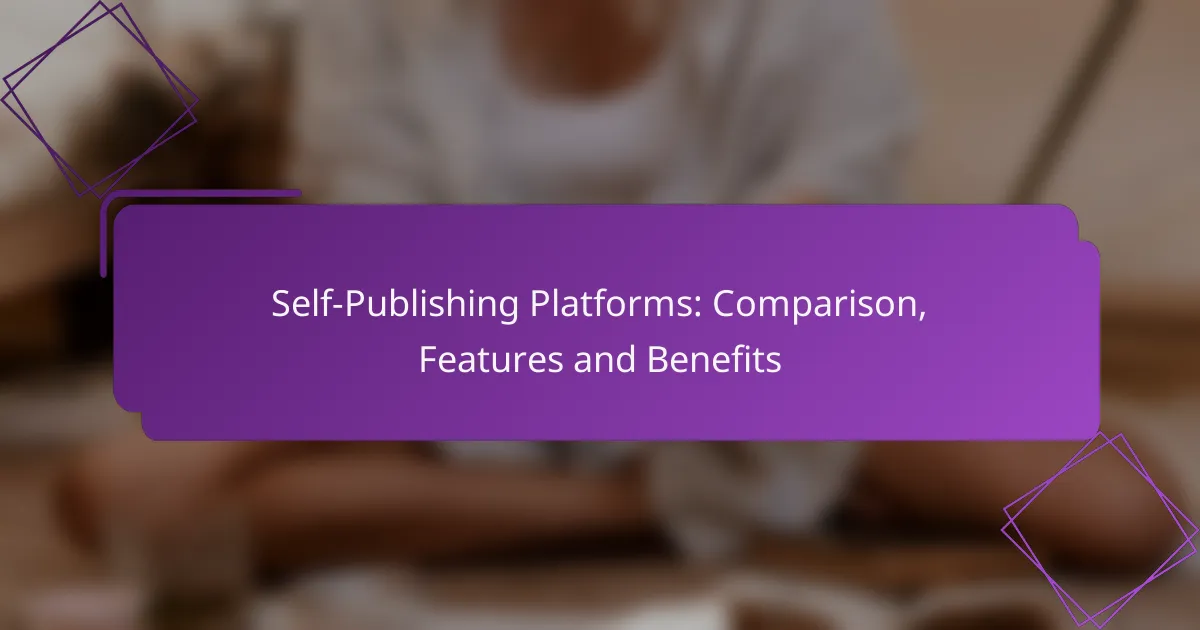In the evolving landscape of self-publishing, authors have access to a variety of platforms such as Amazon Kindle Direct Publishing and IngramSpark, each offering distinct features and distribution options. To successfully market their self-published works, authors can employ strategies like social media advertising and email marketing, while utilizing tools that enhance engagement and visibility. By understanding these platforms and marketing techniques, authors can effectively connect with their target audience and maximize their book’s impact.

What are the best self-publishing platforms for authors?
The best self-publishing platforms for authors include Amazon Kindle Direct Publishing, IngramSpark, Kobo Writing Life, Smashwords, and Draft2Digital. Each platform offers unique features, distribution options, and royalty structures that cater to different author needs and goals.
Amazon Kindle Direct Publishing
Amazon Kindle Direct Publishing (KDP) is one of the most popular self-publishing platforms, allowing authors to publish eBooks and paperbacks directly to Amazon. KDP offers a user-friendly interface, enabling authors to upload their manuscripts and cover designs easily.
Authors can earn up to 70% royalties on eBook sales, depending on the pricing and distribution choices. KDP Select, a program that requires exclusivity, can enhance visibility through promotional tools like Kindle Unlimited.
IngramSpark
IngramSpark is a robust platform that provides authors with access to a vast distribution network, including bookstores and libraries. It allows for both print and eBook publishing, making it a versatile choice for authors looking to reach a wide audience.
While IngramSpark has a setup fee, it offers significant benefits, such as higher quality print options and extensive global distribution. Authors should consider the costs versus the potential reach when choosing this platform.
Kobo Writing Life
Kobo Writing Life is designed for authors who want to publish eBooks and reach international markets. It provides an easy-to-use interface and allows authors to set their own prices and royalties, which can be as high as 70% depending on the price point.
Kobo also offers promotional opportunities through its Kobo Plus subscription service, which can help increase visibility. This platform is particularly popular in Canada and Europe, making it a good option for authors targeting those regions.
Smashwords
Smashwords is a well-established self-publishing platform that focuses on eBooks. It distributes to major retailers and libraries, offering authors a chance to reach a broad audience. The platform supports multiple formats, making it easy to convert manuscripts for various e-readers.
Authors can set their own prices and participate in promotional campaigns. However, the royalty rates vary depending on the retailer, so authors should review the terms carefully to maximize their earnings.
Draft2Digital
Draft2Digital is known for its simplicity and author-friendly approach to self-publishing eBooks. It offers free formatting tools and distributes to numerous retailers, including Apple Books and Barnes & Noble. Authors can easily manage their titles and track sales through a single dashboard.
With competitive royalty rates and no upfront costs, Draft2Digital is an appealing option for new authors. It also provides helpful resources and support to guide authors through the publishing process.

How can authors effectively market their self-published books?
Authors can effectively market their self-published books by leveraging various strategies that enhance visibility and engagement. Key methods include utilizing social media advertising, building an author website, engaging with book bloggers, and leveraging email marketing to reach potential readers.
Utilizing social media advertising
Social media advertising allows authors to target specific demographics, making it easier to reach potential readers. Platforms like Facebook, Instagram, and Twitter offer tools to create ads that can be tailored to interests, age groups, and locations.
When creating ads, use eye-catching visuals and compelling copy to entice clicks. Consider setting a budget that allows for testing different ad formats and audiences to see what performs best, typically starting with a few hundred dollars to gauge effectiveness.
Building an author website
An author website serves as a central hub for marketing efforts, providing information about the author, their books, and upcoming events. It should include a blog, a mailing list sign-up, and links to purchase books on various platforms.
Ensure the website is user-friendly and mobile-responsive. Use SEO best practices to improve visibility in search engines, focusing on keywords related to your genre and book themes to attract organic traffic.
Engaging with book bloggers
Connecting with book bloggers can significantly enhance an author’s reach. These bloggers often have dedicated followers who trust their recommendations, making them valuable allies in promoting self-published works.
To engage effectively, research bloggers who specialize in your genre and reach out with a personalized message. Offer to send them a free copy of your book in exchange for an honest review, and consider participating in interviews or guest posts on their blogs.
Leveraging email marketing
Email marketing is a powerful tool for maintaining contact with readers and promoting new releases. Building an email list allows authors to communicate directly with their audience, offering exclusive content, updates, and special promotions.
Use a service like Mailchimp or ConvertKit to manage your list and create visually appealing newsletters. Aim to send regular updates, but avoid overwhelming subscribers; a monthly newsletter is often sufficient to keep readers engaged without causing fatigue.

What tools can enhance self-publishing marketing strategies?
Several tools can significantly boost self-publishing marketing strategies by streamlining design, communication, and audience engagement. Utilizing the right platforms can help authors effectively reach their target readers and promote their work.
Canva for graphic design
Canva is a user-friendly graphic design tool that allows authors to create visually appealing marketing materials without needing extensive design skills. It offers a wide range of templates for book covers, social media posts, and promotional graphics.
To maximize its potential, authors should focus on maintaining brand consistency in colors and fonts across all materials. Regularly updating visuals can also keep the audience engaged and interested in new releases.
Mailchimp for email campaigns
Mailchimp is an effective platform for managing email marketing campaigns, allowing authors to build and maintain a mailing list of readers. It offers customizable templates and automation features that help streamline communication with subscribers.
Authors should segment their audience based on interests or reading habits to send targeted messages. A/B testing subject lines and content can also improve open and click-through rates, ensuring that campaigns resonate with readers.
Hootsuite for social media management
Hootsuite is a comprehensive social media management tool that enables authors to schedule posts, track engagement, and analyze performance across various platforms. This can save time and ensure consistent interaction with followers.
Authors should use Hootsuite to monitor trends and engage with their audience in real-time. Regularly reviewing analytics can help refine strategies and identify the best times to post for maximum visibility.
BookFunnel for reader magnets
BookFunnel is a platform designed to help authors distribute free or discounted books, often referred to as reader magnets, to attract new readers. It simplifies the process of delivering eBooks and collecting email addresses in exchange.
When using BookFunnel, authors should consider creating a compelling landing page that highlights the benefits of signing up. Offering exclusive content or early access to new releases can further incentivize readers to join the mailing list.

What are the costs associated with self-publishing platforms?
Self-publishing platforms come with various costs that authors need to consider, including setup fees, printing costs, and marketing expenses. Understanding these costs can help authors budget effectively and maximize their potential earnings.
Amazon KDP fees
Amazon Kindle Direct Publishing (KDP) has no upfront fees, but it takes a percentage of your royalties. Typically, authors earn 35% to 70% of the book’s sale price, depending on the pricing strategy and distribution options chosen.
Additionally, if you opt for expanded distribution, there may be further deductions from your royalties. It’s essential to factor in these percentages when setting your book’s price to ensure profitability.
IngramSpark setup costs
IngramSpark charges a setup fee for each title you publish, which can range from around $49 to $99. This fee covers the distribution of your book to various retailers and libraries worldwide.
Authors should also consider additional costs for revisions or updates to their titles, as IngramSpark may charge fees for these changes. Budgeting for these potential expenses is crucial for a smooth publishing experience.
Marketing budget considerations
Marketing is a vital aspect of self-publishing, and authors should allocate a budget for promotional activities. A reasonable marketing budget can range from a few hundred to several thousand dollars, depending on the strategies employed.
Common marketing expenses include social media advertising, book launch events, and promotional materials. Authors should prioritize their spending based on their target audience and marketing goals to ensure effective use of their resources.



